Management Communication: Formal and Personal Strategies Report
VerifiedAdded on 2023/06/05
|21
|4755
|365
Report
AI Summary
This report investigates management communication, focusing on both interpersonal and formal communication channels within a workplace setting. It begins by defining professional communication and its significance in organizational management, emphasizing the impact of communication channels on organizational integrity. The report delves into interpersonal communication, exploring its elements, including communicators, message, noise, feedback, context, and channel, and examines various communication types such as problem-solving, decision-making, listening, assertiveness, and negotiation. It identifies the benefits of interpersonal communication, such as improving integrity and preserving ethics, while also highlighting barriers like geographical and cultural differences, and inappropriate channels. The report then transitions to formal communication, discussing its characteristics, components, and flow within a chain of command. It explores the establishment and maintenance of formal and informal channels (downward, upward, and horizontal) and highlights the importance of effective communication for organizational success. The report concludes by emphasizing the need for strategic communication to resolve existing issues and enhance workforce communication.
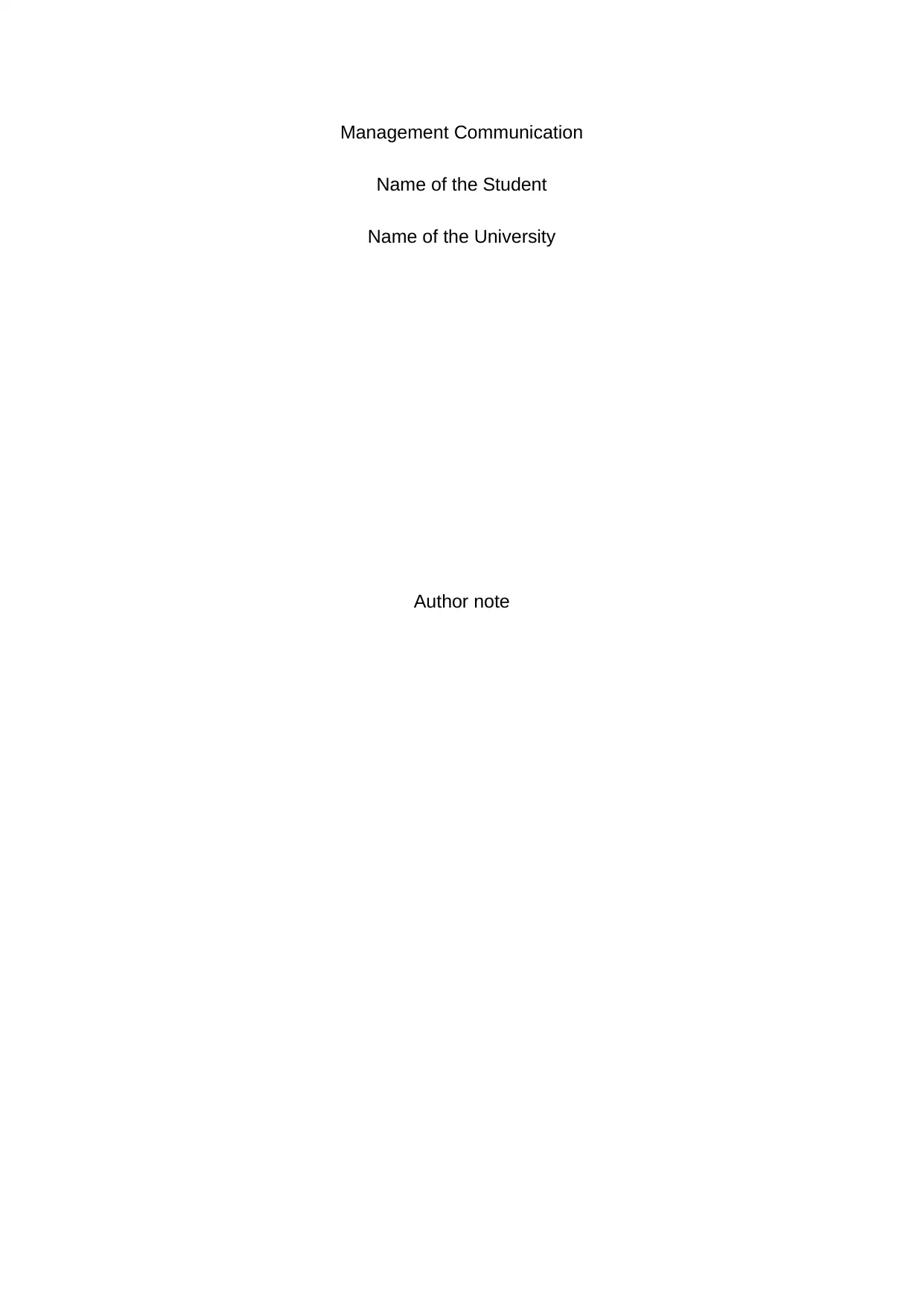
Management Communication
Name of the Student
Name of the University
Author note
Name of the Student
Name of the University
Author note
Paraphrase This Document
Need a fresh take? Get an instant paraphrase of this document with our AI Paraphraser
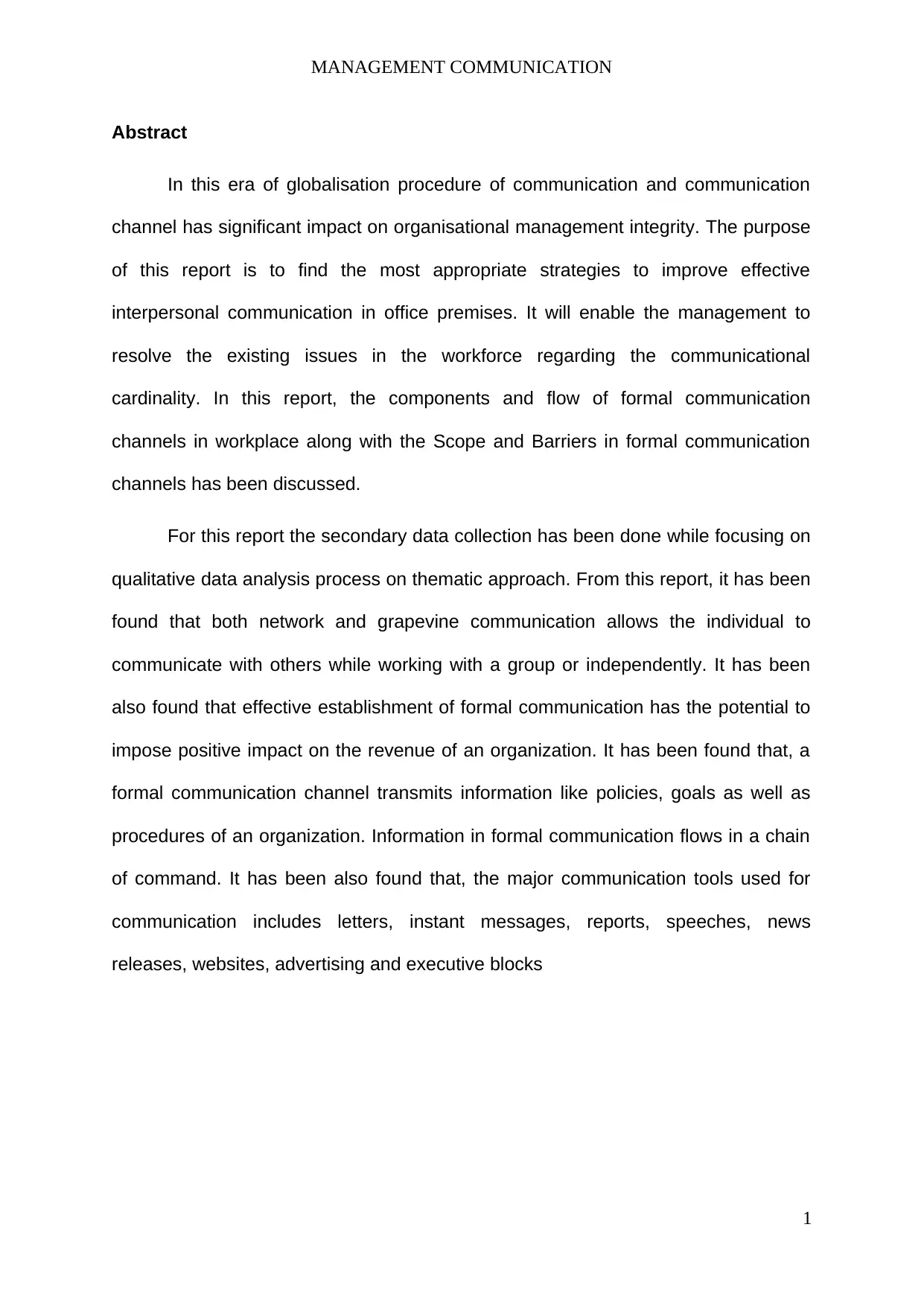
MANAGEMENT COMMUNICATION
Abstract
In this era of globalisation procedure of communication and communication
channel has significant impact on organisational management integrity. The purpose
of this report is to find the most appropriate strategies to improve effective
interpersonal communication in office premises. It will enable the management to
resolve the existing issues in the workforce regarding the communicational
cardinality. In this report, the components and flow of formal communication
channels in workplace along with the Scope and Barriers in formal communication
channels has been discussed.
For this report the secondary data collection has been done while focusing on
qualitative data analysis process on thematic approach. From this report, it has been
found that both network and grapevine communication allows the individual to
communicate with others while working with a group or independently. It has been
also found that effective establishment of formal communication has the potential to
impose positive impact on the revenue of an organization. It has been found that, a
formal communication channel transmits information like policies, goals as well as
procedures of an organization. Information in formal communication flows in a chain
of command. It has been also found that, the major communication tools used for
communication includes letters, instant messages, reports, speeches, news
releases, websites, advertising and executive blocks
1
Abstract
In this era of globalisation procedure of communication and communication
channel has significant impact on organisational management integrity. The purpose
of this report is to find the most appropriate strategies to improve effective
interpersonal communication in office premises. It will enable the management to
resolve the existing issues in the workforce regarding the communicational
cardinality. In this report, the components and flow of formal communication
channels in workplace along with the Scope and Barriers in formal communication
channels has been discussed.
For this report the secondary data collection has been done while focusing on
qualitative data analysis process on thematic approach. From this report, it has been
found that both network and grapevine communication allows the individual to
communicate with others while working with a group or independently. It has been
also found that effective establishment of formal communication has the potential to
impose positive impact on the revenue of an organization. It has been found that, a
formal communication channel transmits information like policies, goals as well as
procedures of an organization. Information in formal communication flows in a chain
of command. It has been also found that, the major communication tools used for
communication includes letters, instant messages, reports, speeches, news
releases, websites, advertising and executive blocks
1
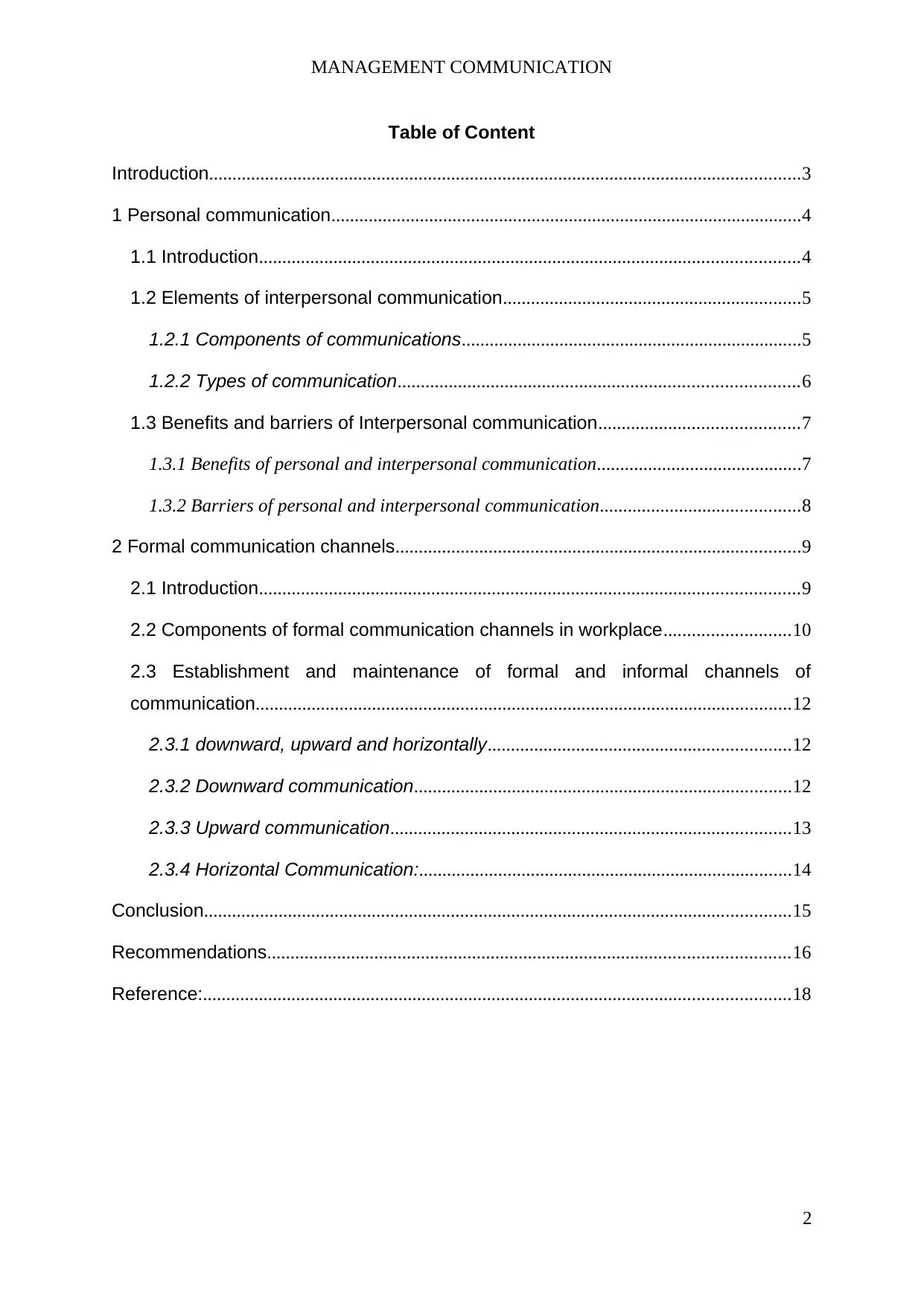
MANAGEMENT COMMUNICATION
Table of Content
Introduction...............................................................................................................................3
1 Personal communication.....................................................................................................4
1.1 Introduction....................................................................................................................4
1.2 Elements of interpersonal communication................................................................5
1.2.1 Components of communications.........................................................................5
1.2.2 Types of communication......................................................................................6
1.3 Benefits and barriers of Interpersonal communication...........................................7
1.3.1 Benefits of personal and interpersonal communication............................................7
1.3.2 Barriers of personal and interpersonal communication...........................................8
2 Formal communication channels.......................................................................................9
2.1 Introduction....................................................................................................................9
2.2 Components of formal communication channels in workplace...........................10
2.3 Establishment and maintenance of formal and informal channels of
communication...................................................................................................................12
2.3.1 downward, upward and horizontally.................................................................12
2.3.2 Downward communication.................................................................................12
2.3.3 Upward communication......................................................................................13
2.3.4 Horizontal Communication:................................................................................14
Conclusion..............................................................................................................................15
Recommendations................................................................................................................16
Reference:..............................................................................................................................18
2
Table of Content
Introduction...............................................................................................................................3
1 Personal communication.....................................................................................................4
1.1 Introduction....................................................................................................................4
1.2 Elements of interpersonal communication................................................................5
1.2.1 Components of communications.........................................................................5
1.2.2 Types of communication......................................................................................6
1.3 Benefits and barriers of Interpersonal communication...........................................7
1.3.1 Benefits of personal and interpersonal communication............................................7
1.3.2 Barriers of personal and interpersonal communication...........................................8
2 Formal communication channels.......................................................................................9
2.1 Introduction....................................................................................................................9
2.2 Components of formal communication channels in workplace...........................10
2.3 Establishment and maintenance of formal and informal channels of
communication...................................................................................................................12
2.3.1 downward, upward and horizontally.................................................................12
2.3.2 Downward communication.................................................................................12
2.3.3 Upward communication......................................................................................13
2.3.4 Horizontal Communication:................................................................................14
Conclusion..............................................................................................................................15
Recommendations................................................................................................................16
Reference:..............................................................................................................................18
2
⊘ This is a preview!⊘
Do you want full access?
Subscribe today to unlock all pages.

Trusted by 1+ million students worldwide
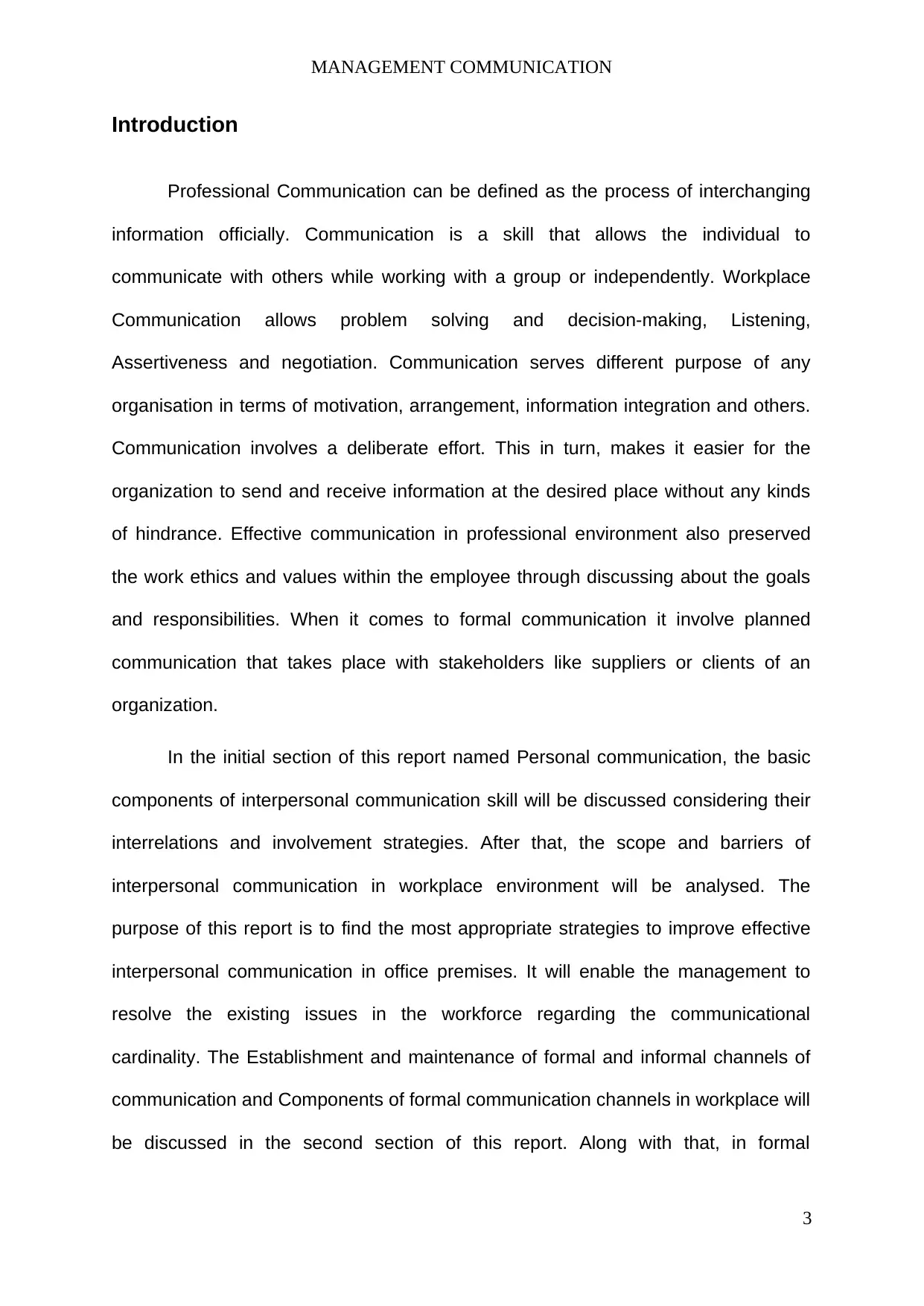
MANAGEMENT COMMUNICATION
Introduction
Professional Communication can be defined as the process of interchanging
information officially. Communication is a skill that allows the individual to
communicate with others while working with a group or independently. Workplace
Communication allows problem solving and decision-making, Listening,
Assertiveness and negotiation. Communication serves different purpose of any
organisation in terms of motivation, arrangement, information integration and others.
Communication involves a deliberate effort. This in turn, makes it easier for the
organization to send and receive information at the desired place without any kinds
of hindrance. Effective communication in professional environment also preserved
the work ethics and values within the employee through discussing about the goals
and responsibilities. When it comes to formal communication it involve planned
communication that takes place with stakeholders like suppliers or clients of an
organization.
In the initial section of this report named Personal communication, the basic
components of interpersonal communication skill will be discussed considering their
interrelations and involvement strategies. After that, the scope and barriers of
interpersonal communication in workplace environment will be analysed. The
purpose of this report is to find the most appropriate strategies to improve effective
interpersonal communication in office premises. It will enable the management to
resolve the existing issues in the workforce regarding the communicational
cardinality. The Establishment and maintenance of formal and informal channels of
communication and Components of formal communication channels in workplace will
be discussed in the second section of this report. Along with that, in formal
3
Introduction
Professional Communication can be defined as the process of interchanging
information officially. Communication is a skill that allows the individual to
communicate with others while working with a group or independently. Workplace
Communication allows problem solving and decision-making, Listening,
Assertiveness and negotiation. Communication serves different purpose of any
organisation in terms of motivation, arrangement, information integration and others.
Communication involves a deliberate effort. This in turn, makes it easier for the
organization to send and receive information at the desired place without any kinds
of hindrance. Effective communication in professional environment also preserved
the work ethics and values within the employee through discussing about the goals
and responsibilities. When it comes to formal communication it involve planned
communication that takes place with stakeholders like suppliers or clients of an
organization.
In the initial section of this report named Personal communication, the basic
components of interpersonal communication skill will be discussed considering their
interrelations and involvement strategies. After that, the scope and barriers of
interpersonal communication in workplace environment will be analysed. The
purpose of this report is to find the most appropriate strategies to improve effective
interpersonal communication in office premises. It will enable the management to
resolve the existing issues in the workforce regarding the communicational
cardinality. The Establishment and maintenance of formal and informal channels of
communication and Components of formal communication channels in workplace will
be discussed in the second section of this report. Along with that, in formal
3
Paraphrase This Document
Need a fresh take? Get an instant paraphrase of this document with our AI Paraphraser
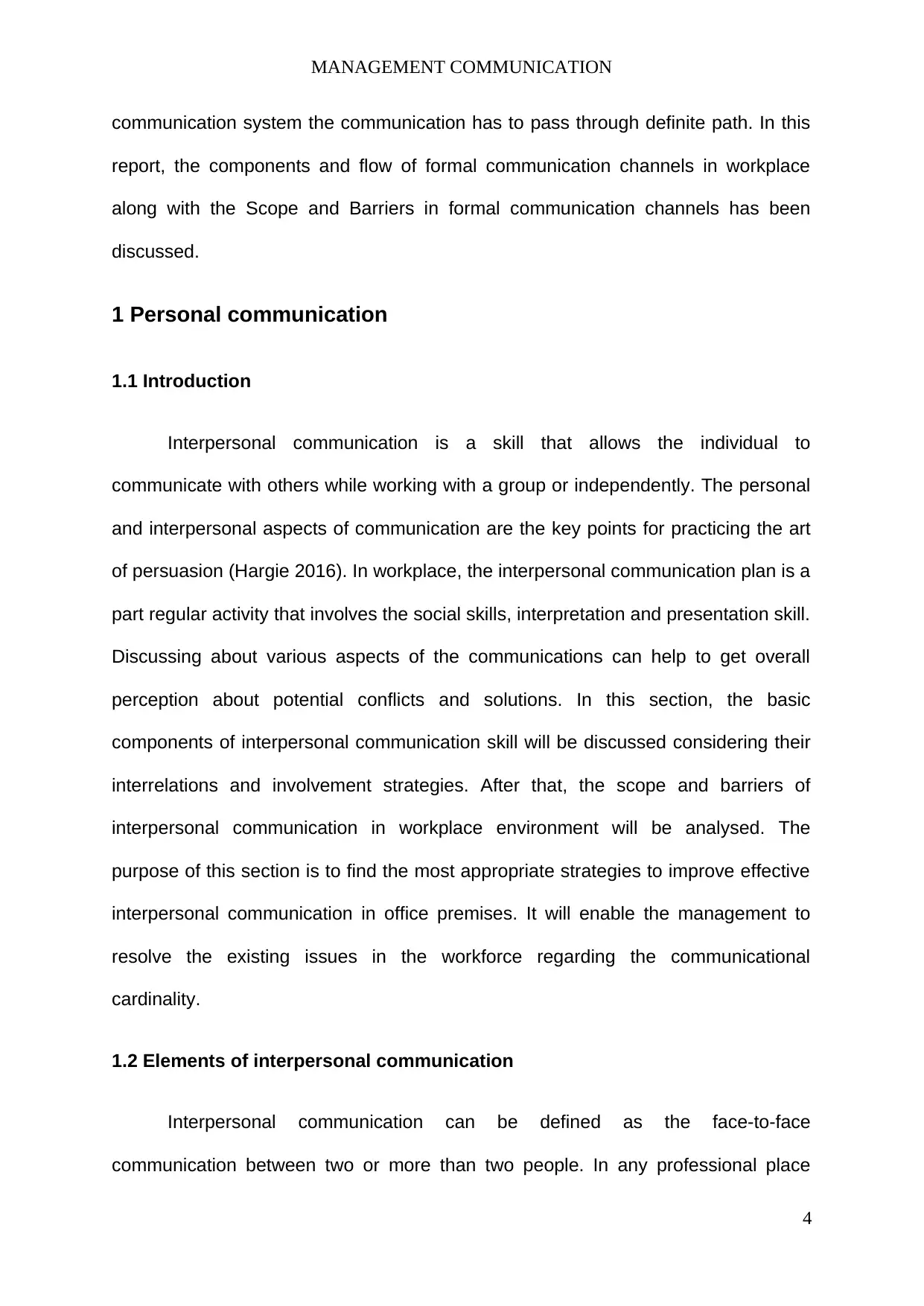
MANAGEMENT COMMUNICATION
communication system the communication has to pass through definite path. In this
report, the components and flow of formal communication channels in workplace
along with the Scope and Barriers in formal communication channels has been
discussed.
1 Personal communication
1.1 Introduction
Interpersonal communication is a skill that allows the individual to
communicate with others while working with a group or independently. The personal
and interpersonal aspects of communication are the key points for practicing the art
of persuasion (Hargie 2016). In workplace, the interpersonal communication plan is a
part regular activity that involves the social skills, interpretation and presentation skill.
Discussing about various aspects of the communications can help to get overall
perception about potential conflicts and solutions. In this section, the basic
components of interpersonal communication skill will be discussed considering their
interrelations and involvement strategies. After that, the scope and barriers of
interpersonal communication in workplace environment will be analysed. The
purpose of this section is to find the most appropriate strategies to improve effective
interpersonal communication in office premises. It will enable the management to
resolve the existing issues in the workforce regarding the communicational
cardinality.
1.2 Elements of interpersonal communication
Interpersonal communication can be defined as the face-to-face
communication between two or more than two people. In any professional place
4
communication system the communication has to pass through definite path. In this
report, the components and flow of formal communication channels in workplace
along with the Scope and Barriers in formal communication channels has been
discussed.
1 Personal communication
1.1 Introduction
Interpersonal communication is a skill that allows the individual to
communicate with others while working with a group or independently. The personal
and interpersonal aspects of communication are the key points for practicing the art
of persuasion (Hargie 2016). In workplace, the interpersonal communication plan is a
part regular activity that involves the social skills, interpretation and presentation skill.
Discussing about various aspects of the communications can help to get overall
perception about potential conflicts and solutions. In this section, the basic
components of interpersonal communication skill will be discussed considering their
interrelations and involvement strategies. After that, the scope and barriers of
interpersonal communication in workplace environment will be analysed. The
purpose of this section is to find the most appropriate strategies to improve effective
interpersonal communication in office premises. It will enable the management to
resolve the existing issues in the workforce regarding the communicational
cardinality.
1.2 Elements of interpersonal communication
Interpersonal communication can be defined as the face-to-face
communication between two or more than two people. In any professional place
4
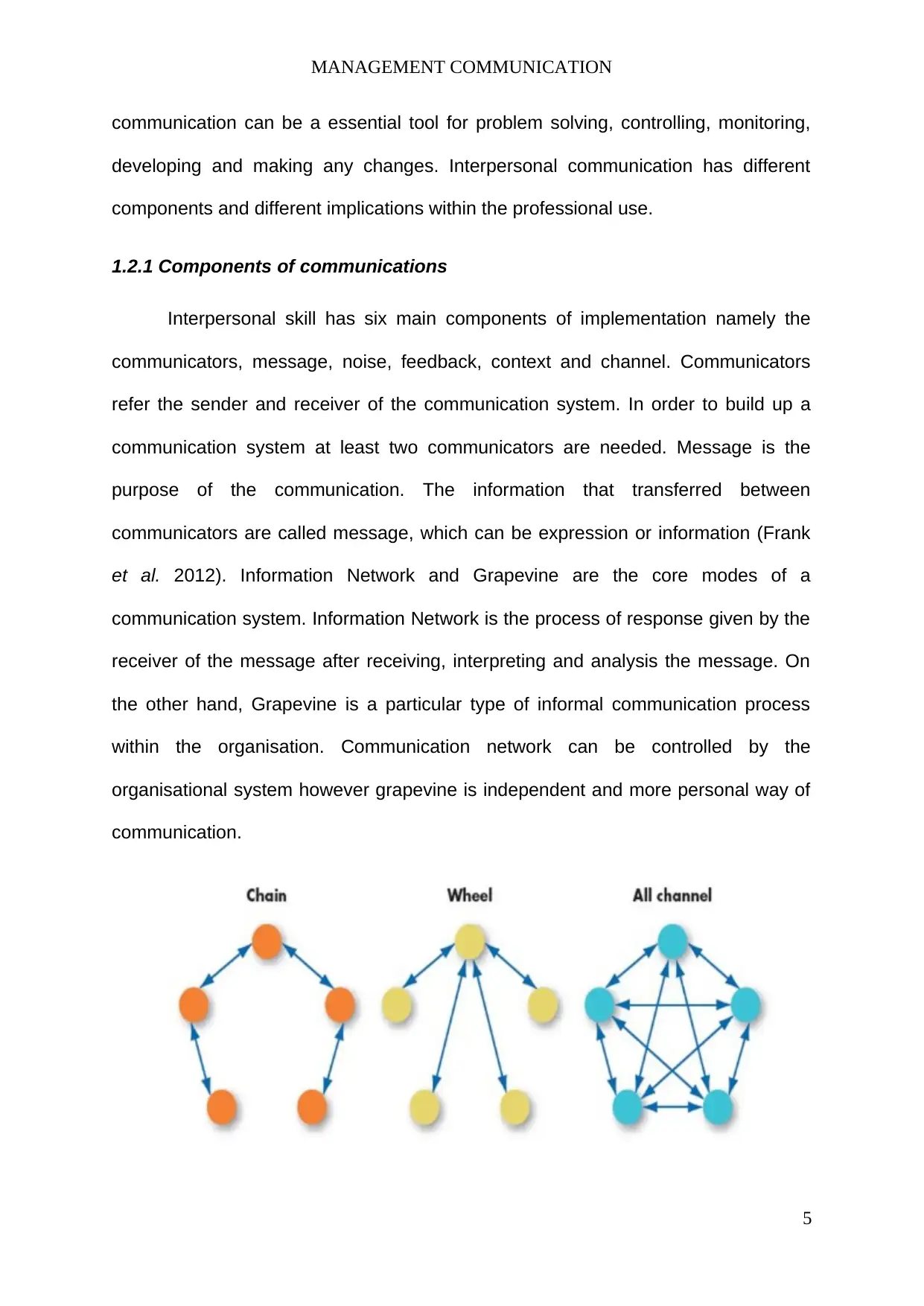
MANAGEMENT COMMUNICATION
communication can be a essential tool for problem solving, controlling, monitoring,
developing and making any changes. Interpersonal communication has different
components and different implications within the professional use.
1.2.1 Components of communications
Interpersonal skill has six main components of implementation namely the
communicators, message, noise, feedback, context and channel. Communicators
refer the sender and receiver of the communication system. In order to build up a
communication system at least two communicators are needed. Message is the
purpose of the communication. The information that transferred between
communicators are called message, which can be expression or information (Frank
et al. 2012). Information Network and Grapevine are the core modes of a
communication system. Information Network is the process of response given by the
receiver of the message after receiving, interpreting and analysis the message. On
the other hand, Grapevine is a particular type of informal communication process
within the organisation. Communication network can be controlled by the
organisational system however grapevine is independent and more personal way of
communication.
5
communication can be a essential tool for problem solving, controlling, monitoring,
developing and making any changes. Interpersonal communication has different
components and different implications within the professional use.
1.2.1 Components of communications
Interpersonal skill has six main components of implementation namely the
communicators, message, noise, feedback, context and channel. Communicators
refer the sender and receiver of the communication system. In order to build up a
communication system at least two communicators are needed. Message is the
purpose of the communication. The information that transferred between
communicators are called message, which can be expression or information (Frank
et al. 2012). Information Network and Grapevine are the core modes of a
communication system. Information Network is the process of response given by the
receiver of the message after receiving, interpreting and analysis the message. On
the other hand, Grapevine is a particular type of informal communication process
within the organisation. Communication network can be controlled by the
organisational system however grapevine is independent and more personal way of
communication.
5
⊘ This is a preview!⊘
Do you want full access?
Subscribe today to unlock all pages.

Trusted by 1+ million students worldwide
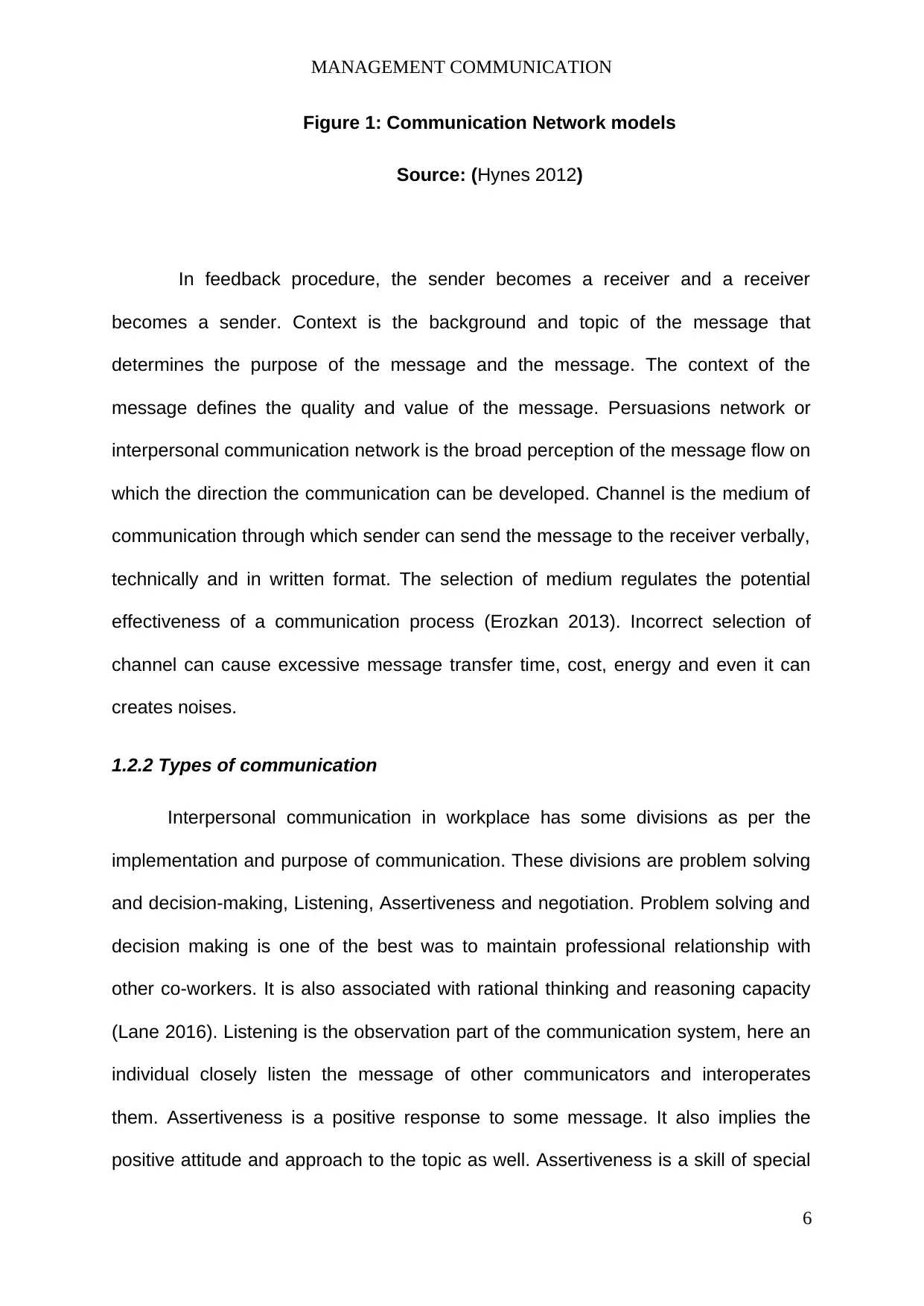
MANAGEMENT COMMUNICATION
Figure 1: Communication Network models
Source: (Hynes 2012)
In feedback procedure, the sender becomes a receiver and a receiver
becomes a sender. Context is the background and topic of the message that
determines the purpose of the message and the message. The context of the
message defines the quality and value of the message. Persuasions network or
interpersonal communication network is the broad perception of the message flow on
which the direction the communication can be developed. Channel is the medium of
communication through which sender can send the message to the receiver verbally,
technically and in written format. The selection of medium regulates the potential
effectiveness of a communication process (Erozkan 2013). Incorrect selection of
channel can cause excessive message transfer time, cost, energy and even it can
creates noises.
1.2.2 Types of communication
Interpersonal communication in workplace has some divisions as per the
implementation and purpose of communication. These divisions are problem solving
and decision-making, Listening, Assertiveness and negotiation. Problem solving and
decision making is one of the best was to maintain professional relationship with
other co-workers. It is also associated with rational thinking and reasoning capacity
(Lane 2016). Listening is the observation part of the communication system, here an
individual closely listen the message of other communicators and interoperates
them. Assertiveness is a positive response to some message. It also implies the
positive attitude and approach to the topic as well. Assertiveness is a skill of special
6
Figure 1: Communication Network models
Source: (Hynes 2012)
In feedback procedure, the sender becomes a receiver and a receiver
becomes a sender. Context is the background and topic of the message that
determines the purpose of the message and the message. The context of the
message defines the quality and value of the message. Persuasions network or
interpersonal communication network is the broad perception of the message flow on
which the direction the communication can be developed. Channel is the medium of
communication through which sender can send the message to the receiver verbally,
technically and in written format. The selection of medium regulates the potential
effectiveness of a communication process (Erozkan 2013). Incorrect selection of
channel can cause excessive message transfer time, cost, energy and even it can
creates noises.
1.2.2 Types of communication
Interpersonal communication in workplace has some divisions as per the
implementation and purpose of communication. These divisions are problem solving
and decision-making, Listening, Assertiveness and negotiation. Problem solving and
decision making is one of the best was to maintain professional relationship with
other co-workers. It is also associated with rational thinking and reasoning capacity
(Lane 2016). Listening is the observation part of the communication system, here an
individual closely listen the message of other communicators and interoperates
them. Assertiveness is a positive response to some message. It also implies the
positive attitude and approach to the topic as well. Assertiveness is a skill of special
6
Paraphrase This Document
Need a fresh take? Get an instant paraphrase of this document with our AI Paraphraser
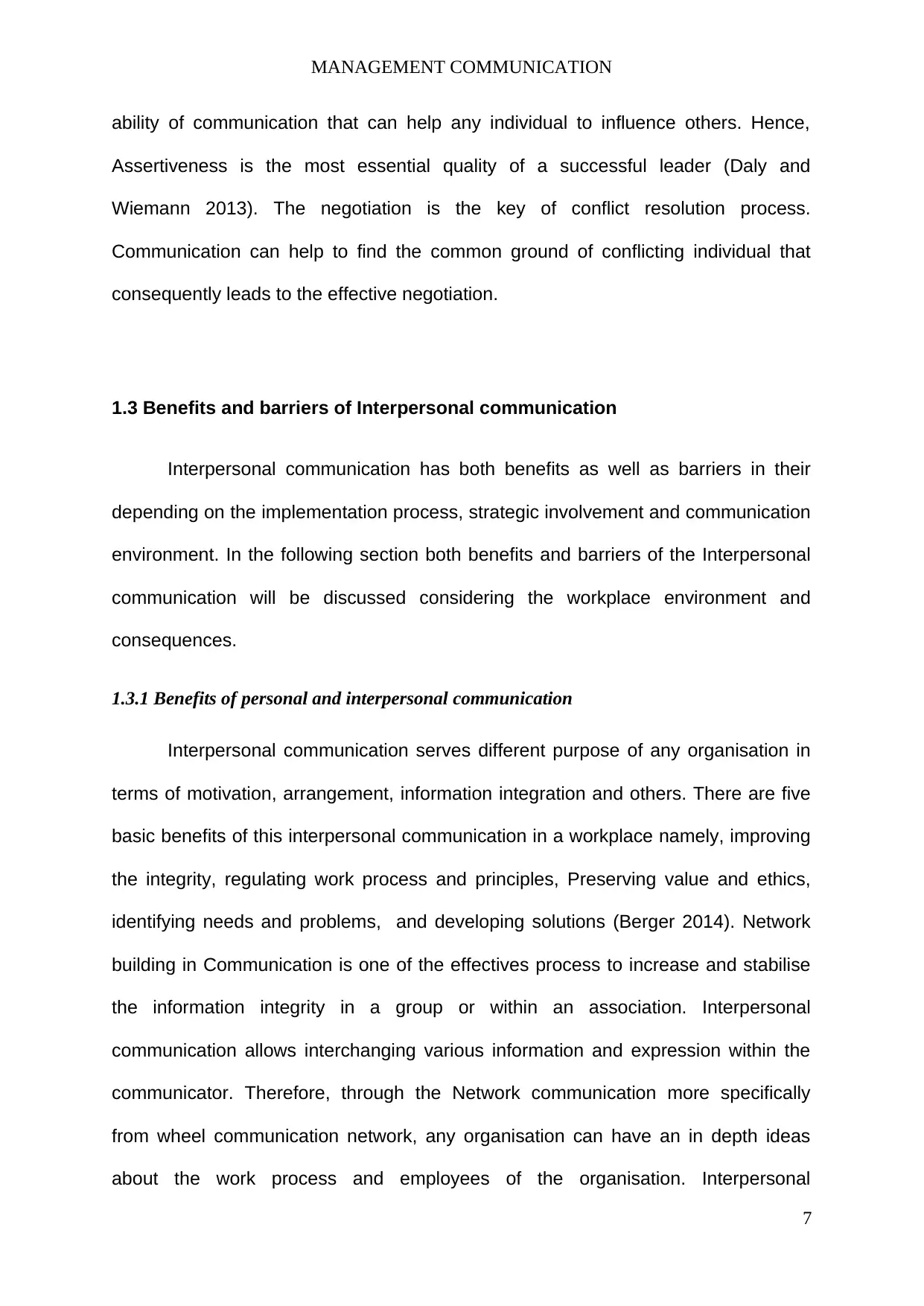
MANAGEMENT COMMUNICATION
ability of communication that can help any individual to influence others. Hence,
Assertiveness is the most essential quality of a successful leader (Daly and
Wiemann 2013). The negotiation is the key of conflict resolution process.
Communication can help to find the common ground of conflicting individual that
consequently leads to the effective negotiation.
1.3 Benefits and barriers of Interpersonal communication
Interpersonal communication has both benefits as well as barriers in their
depending on the implementation process, strategic involvement and communication
environment. In the following section both benefits and barriers of the Interpersonal
communication will be discussed considering the workplace environment and
consequences.
1.3.1 Benefits of personal and interpersonal communication
Interpersonal communication serves different purpose of any organisation in
terms of motivation, arrangement, information integration and others. There are five
basic benefits of this interpersonal communication in a workplace namely, improving
the integrity, regulating work process and principles, Preserving value and ethics,
identifying needs and problems, and developing solutions (Berger 2014). Network
building in Communication is one of the effectives process to increase and stabilise
the information integrity in a group or within an association. Interpersonal
communication allows interchanging various information and expression within the
communicator. Therefore, through the Network communication more specifically
from wheel communication network, any organisation can have an in depth ideas
about the work process and employees of the organisation. Interpersonal
7
ability of communication that can help any individual to influence others. Hence,
Assertiveness is the most essential quality of a successful leader (Daly and
Wiemann 2013). The negotiation is the key of conflict resolution process.
Communication can help to find the common ground of conflicting individual that
consequently leads to the effective negotiation.
1.3 Benefits and barriers of Interpersonal communication
Interpersonal communication has both benefits as well as barriers in their
depending on the implementation process, strategic involvement and communication
environment. In the following section both benefits and barriers of the Interpersonal
communication will be discussed considering the workplace environment and
consequences.
1.3.1 Benefits of personal and interpersonal communication
Interpersonal communication serves different purpose of any organisation in
terms of motivation, arrangement, information integration and others. There are five
basic benefits of this interpersonal communication in a workplace namely, improving
the integrity, regulating work process and principles, Preserving value and ethics,
identifying needs and problems, and developing solutions (Berger 2014). Network
building in Communication is one of the effectives process to increase and stabilise
the information integrity in a group or within an association. Interpersonal
communication allows interchanging various information and expression within the
communicator. Therefore, through the Network communication more specifically
from wheel communication network, any organisation can have an in depth ideas
about the work process and employees of the organisation. Interpersonal
7
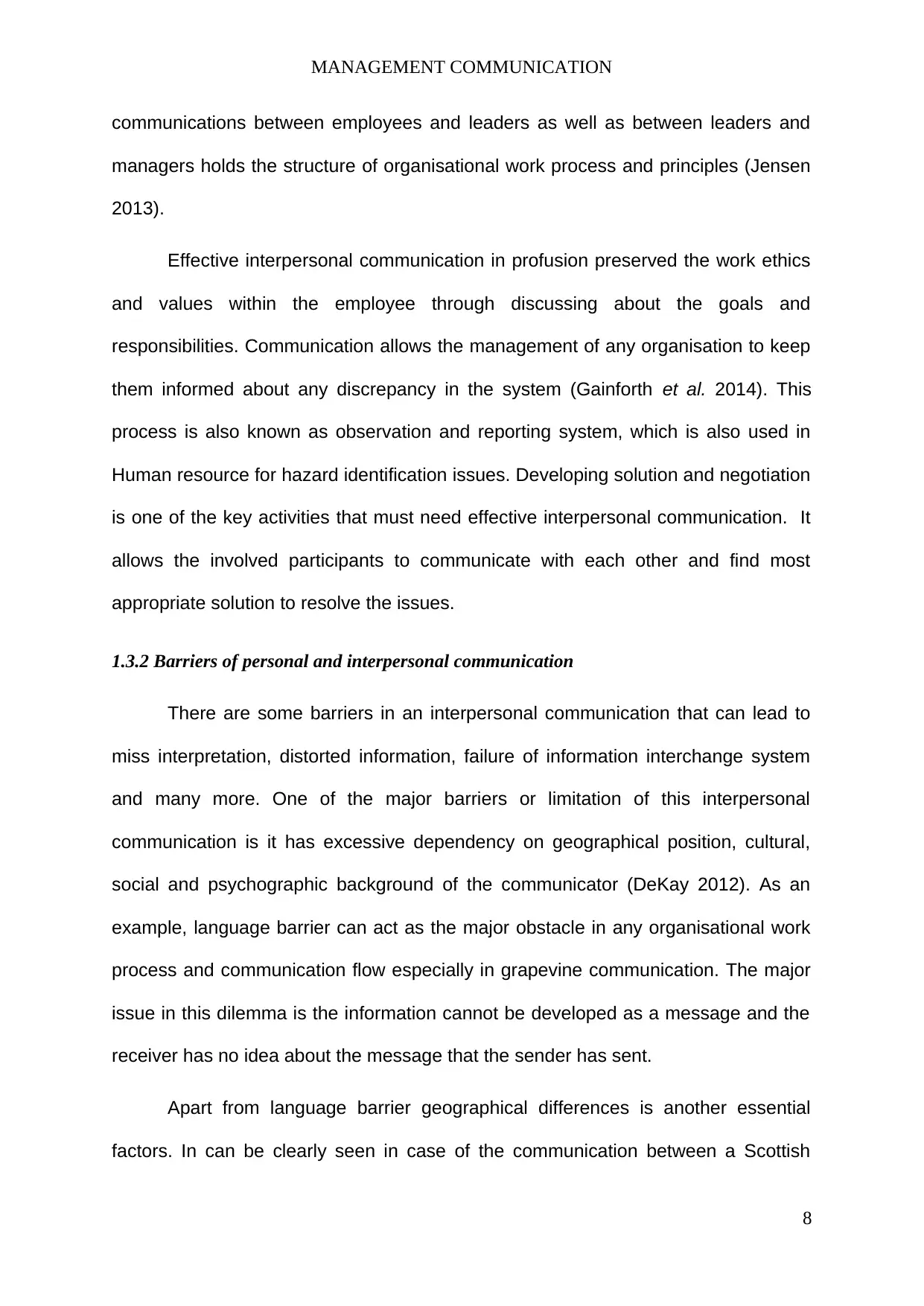
MANAGEMENT COMMUNICATION
communications between employees and leaders as well as between leaders and
managers holds the structure of organisational work process and principles (Jensen
2013).
Effective interpersonal communication in profusion preserved the work ethics
and values within the employee through discussing about the goals and
responsibilities. Communication allows the management of any organisation to keep
them informed about any discrepancy in the system (Gainforth et al. 2014). This
process is also known as observation and reporting system, which is also used in
Human resource for hazard identification issues. Developing solution and negotiation
is one of the key activities that must need effective interpersonal communication. It
allows the involved participants to communicate with each other and find most
appropriate solution to resolve the issues.
1.3.2 Barriers of personal and interpersonal communication
There are some barriers in an interpersonal communication that can lead to
miss interpretation, distorted information, failure of information interchange system
and many more. One of the major barriers or limitation of this interpersonal
communication is it has excessive dependency on geographical position, cultural,
social and psychographic background of the communicator (DeKay 2012). As an
example, language barrier can act as the major obstacle in any organisational work
process and communication flow especially in grapevine communication. The major
issue in this dilemma is the information cannot be developed as a message and the
receiver has no idea about the message that the sender has sent.
Apart from language barrier geographical differences is another essential
factors. In can be clearly seen in case of the communication between a Scottish
8
communications between employees and leaders as well as between leaders and
managers holds the structure of organisational work process and principles (Jensen
2013).
Effective interpersonal communication in profusion preserved the work ethics
and values within the employee through discussing about the goals and
responsibilities. Communication allows the management of any organisation to keep
them informed about any discrepancy in the system (Gainforth et al. 2014). This
process is also known as observation and reporting system, which is also used in
Human resource for hazard identification issues. Developing solution and negotiation
is one of the key activities that must need effective interpersonal communication. It
allows the involved participants to communicate with each other and find most
appropriate solution to resolve the issues.
1.3.2 Barriers of personal and interpersonal communication
There are some barriers in an interpersonal communication that can lead to
miss interpretation, distorted information, failure of information interchange system
and many more. One of the major barriers or limitation of this interpersonal
communication is it has excessive dependency on geographical position, cultural,
social and psychographic background of the communicator (DeKay 2012). As an
example, language barrier can act as the major obstacle in any organisational work
process and communication flow especially in grapevine communication. The major
issue in this dilemma is the information cannot be developed as a message and the
receiver has no idea about the message that the sender has sent.
Apart from language barrier geographical differences is another essential
factors. In can be clearly seen in case of the communication between a Scottish
8
⊘ This is a preview!⊘
Do you want full access?
Subscribe today to unlock all pages.

Trusted by 1+ million students worldwide
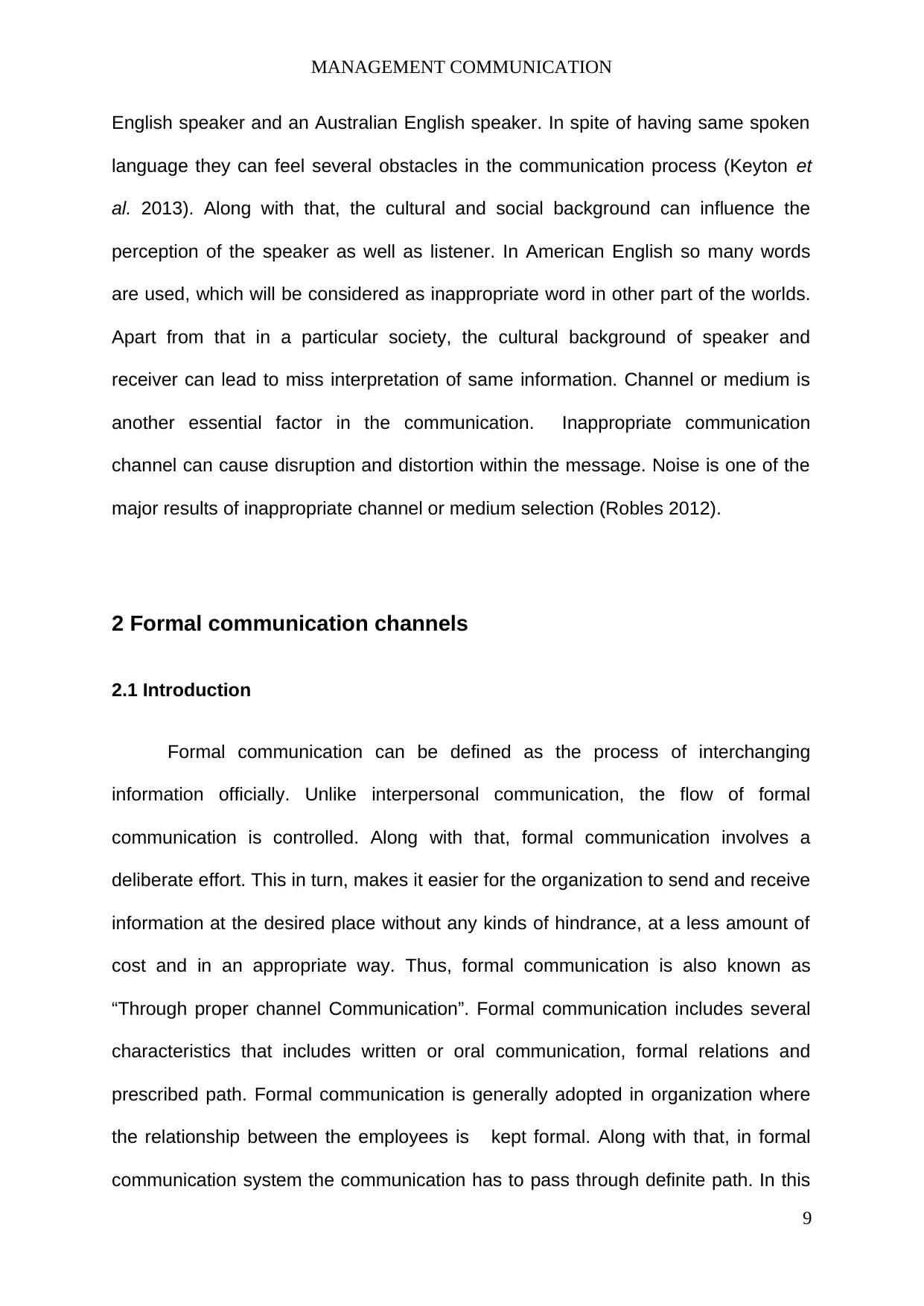
MANAGEMENT COMMUNICATION
English speaker and an Australian English speaker. In spite of having same spoken
language they can feel several obstacles in the communication process (Keyton et
al. 2013). Along with that, the cultural and social background can influence the
perception of the speaker as well as listener. In American English so many words
are used, which will be considered as inappropriate word in other part of the worlds.
Apart from that in a particular society, the cultural background of speaker and
receiver can lead to miss interpretation of same information. Channel or medium is
another essential factor in the communication. Inappropriate communication
channel can cause disruption and distortion within the message. Noise is one of the
major results of inappropriate channel or medium selection (Robles 2012).
2 Formal communication channels
2.1 Introduction
Formal communication can be defined as the process of interchanging
information officially. Unlike interpersonal communication, the flow of formal
communication is controlled. Along with that, formal communication involves a
deliberate effort. This in turn, makes it easier for the organization to send and receive
information at the desired place without any kinds of hindrance, at a less amount of
cost and in an appropriate way. Thus, formal communication is also known as
“Through proper channel Communication”. Formal communication includes several
characteristics that includes written or oral communication, formal relations and
prescribed path. Formal communication is generally adopted in organization where
the relationship between the employees is kept formal. Along with that, in formal
communication system the communication has to pass through definite path. In this
9
English speaker and an Australian English speaker. In spite of having same spoken
language they can feel several obstacles in the communication process (Keyton et
al. 2013). Along with that, the cultural and social background can influence the
perception of the speaker as well as listener. In American English so many words
are used, which will be considered as inappropriate word in other part of the worlds.
Apart from that in a particular society, the cultural background of speaker and
receiver can lead to miss interpretation of same information. Channel or medium is
another essential factor in the communication. Inappropriate communication
channel can cause disruption and distortion within the message. Noise is one of the
major results of inappropriate channel or medium selection (Robles 2012).
2 Formal communication channels
2.1 Introduction
Formal communication can be defined as the process of interchanging
information officially. Unlike interpersonal communication, the flow of formal
communication is controlled. Along with that, formal communication involves a
deliberate effort. This in turn, makes it easier for the organization to send and receive
information at the desired place without any kinds of hindrance, at a less amount of
cost and in an appropriate way. Thus, formal communication is also known as
“Through proper channel Communication”. Formal communication includes several
characteristics that includes written or oral communication, formal relations and
prescribed path. Formal communication is generally adopted in organization where
the relationship between the employees is kept formal. Along with that, in formal
communication system the communication has to pass through definite path. In this
9
Paraphrase This Document
Need a fresh take? Get an instant paraphrase of this document with our AI Paraphraser
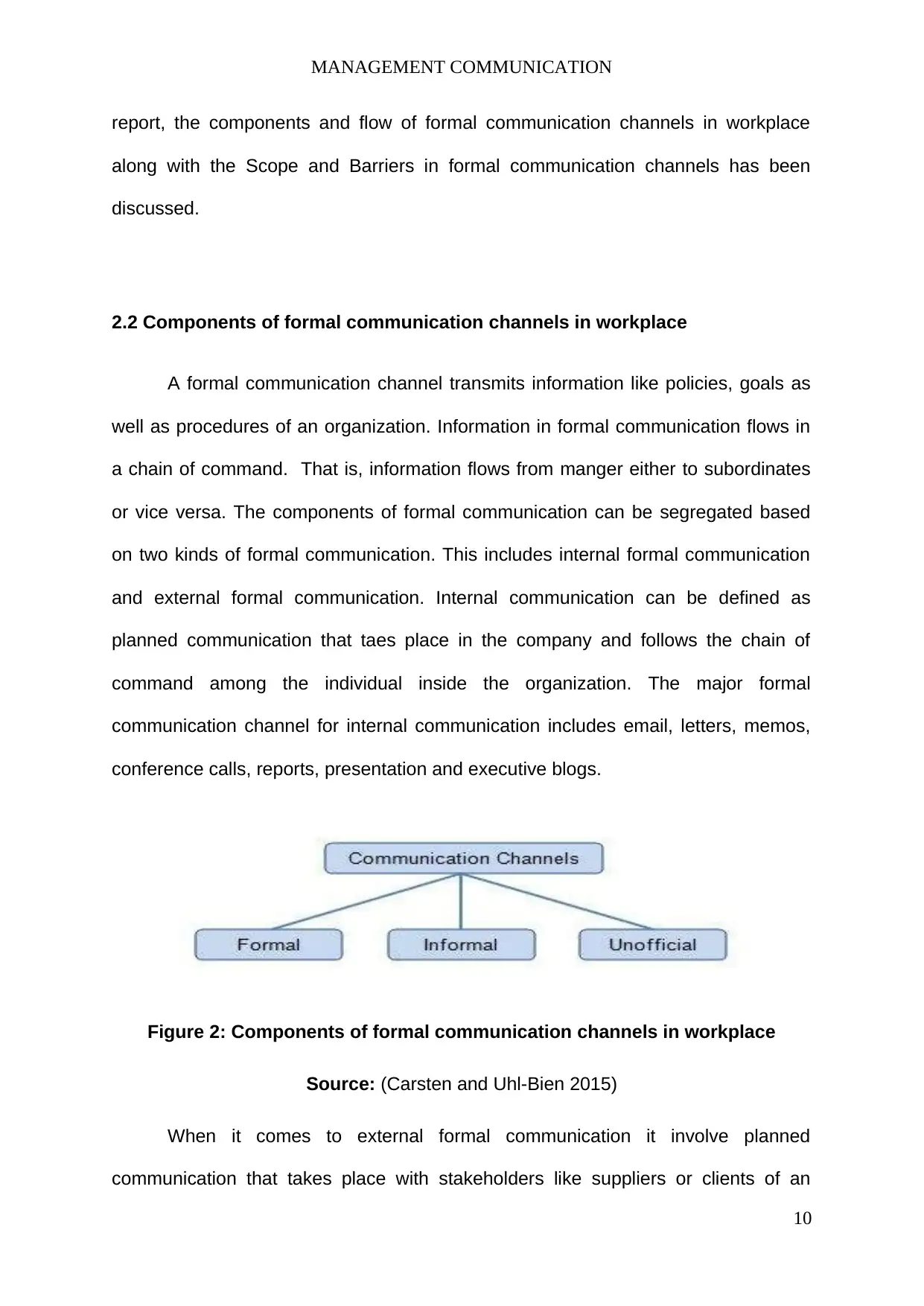
MANAGEMENT COMMUNICATION
report, the components and flow of formal communication channels in workplace
along with the Scope and Barriers in formal communication channels has been
discussed.
2.2 Components of formal communication channels in workplace
A formal communication channel transmits information like policies, goals as
well as procedures of an organization. Information in formal communication flows in
a chain of command. That is, information flows from manger either to subordinates
or vice versa. The components of formal communication can be segregated based
on two kinds of formal communication. This includes internal formal communication
and external formal communication. Internal communication can be defined as
planned communication that taes place in the company and follows the chain of
command among the individual inside the organization. The major formal
communication channel for internal communication includes email, letters, memos,
conference calls, reports, presentation and executive blogs.
Figure 2: Components of formal communication channels in workplace
Source: (Carsten and Uhl-Bien 2015)
When it comes to external formal communication it involve planned
communication that takes place with stakeholders like suppliers or clients of an
10
report, the components and flow of formal communication channels in workplace
along with the Scope and Barriers in formal communication channels has been
discussed.
2.2 Components of formal communication channels in workplace
A formal communication channel transmits information like policies, goals as
well as procedures of an organization. Information in formal communication flows in
a chain of command. That is, information flows from manger either to subordinates
or vice versa. The components of formal communication can be segregated based
on two kinds of formal communication. This includes internal formal communication
and external formal communication. Internal communication can be defined as
planned communication that taes place in the company and follows the chain of
command among the individual inside the organization. The major formal
communication channel for internal communication includes email, letters, memos,
conference calls, reports, presentation and executive blogs.
Figure 2: Components of formal communication channels in workplace
Source: (Carsten and Uhl-Bien 2015)
When it comes to external formal communication it involve planned
communication that takes place with stakeholders like suppliers or clients of an
10
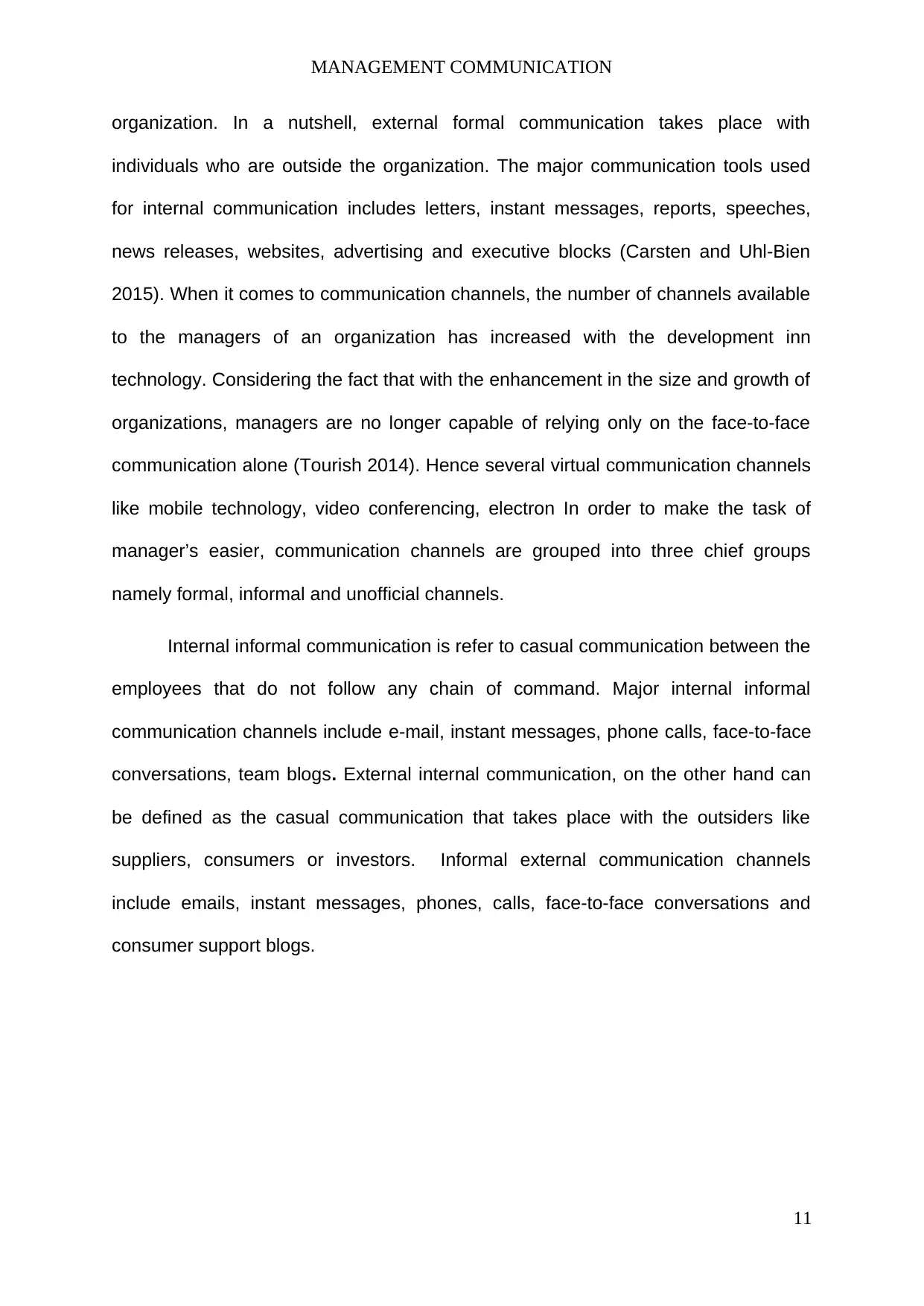
MANAGEMENT COMMUNICATION
organization. In a nutshell, external formal communication takes place with
individuals who are outside the organization. The major communication tools used
for internal communication includes letters, instant messages, reports, speeches,
news releases, websites, advertising and executive blocks (Carsten and Uhl-Bien
2015). When it comes to communication channels, the number of channels available
to the managers of an organization has increased with the development inn
technology. Considering the fact that with the enhancement in the size and growth of
organizations, managers are no longer capable of relying only on the face-to-face
communication alone (Tourish 2014). Hence several virtual communication channels
like mobile technology, video conferencing, electron In order to make the task of
manager’s easier, communication channels are grouped into three chief groups
namely formal, informal and unofficial channels.
Internal informal communication is refer to casual communication between the
employees that do not follow any chain of command. Major internal informal
communication channels include e-mail, instant messages, phone calls, face-to-face
conversations, team blogs. External internal communication, on the other hand can
be defined as the casual communication that takes place with the outsiders like
suppliers, consumers or investors. Informal external communication channels
include emails, instant messages, phones, calls, face-to-face conversations and
consumer support blogs.
11
organization. In a nutshell, external formal communication takes place with
individuals who are outside the organization. The major communication tools used
for internal communication includes letters, instant messages, reports, speeches,
news releases, websites, advertising and executive blocks (Carsten and Uhl-Bien
2015). When it comes to communication channels, the number of channels available
to the managers of an organization has increased with the development inn
technology. Considering the fact that with the enhancement in the size and growth of
organizations, managers are no longer capable of relying only on the face-to-face
communication alone (Tourish 2014). Hence several virtual communication channels
like mobile technology, video conferencing, electron In order to make the task of
manager’s easier, communication channels are grouped into three chief groups
namely formal, informal and unofficial channels.
Internal informal communication is refer to casual communication between the
employees that do not follow any chain of command. Major internal informal
communication channels include e-mail, instant messages, phone calls, face-to-face
conversations, team blogs. External internal communication, on the other hand can
be defined as the casual communication that takes place with the outsiders like
suppliers, consumers or investors. Informal external communication channels
include emails, instant messages, phones, calls, face-to-face conversations and
consumer support blogs.
11
⊘ This is a preview!⊘
Do you want full access?
Subscribe today to unlock all pages.

Trusted by 1+ million students worldwide
1 out of 21
Related Documents
Your All-in-One AI-Powered Toolkit for Academic Success.
+13062052269
info@desklib.com
Available 24*7 on WhatsApp / Email
![[object Object]](/_next/static/media/star-bottom.7253800d.svg)
Unlock your academic potential
Copyright © 2020–2025 A2Z Services. All Rights Reserved. Developed and managed by ZUCOL.



